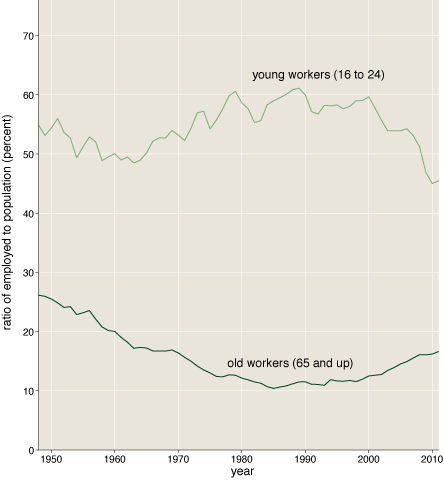The Acceleration of History
by Brian Hayes
Published 20 December 2011
Four hundred years ago, the idea that the Earth goes around the Sun rather than vice versa was not just a scientific breakthrough but also a cultural bombshell. People were asked to reimagine the world they were living in. Not everyone welcomed the opportunity. Books were burned. In the case of Giordano Bruno, an author was burned.
In the modern world, cosmological revolutions seem to cause hardly a ripple in public consciousness. Inflation, dark matter, dark energy—these ideas also call for a reimagining of the world we live in, but they have provoked very little fuss outside the community of science. It’s certainly a relief that no one will be burned at the stake over matters of cosmological doctrine. But are we really more liberal and open-minded, or just not paying attention?
Those are the final paragraphs of my new column in American Scientist. Here I want to say a few words more about the reception of these new ideas in cosmology, but first I should explain that the column is really about something else, namely the Bolshoi computer simulation of the large-scale structure of the universe, led by Joel Primack of UC Santa Cruz and Anatoly Klypin of New Mexico State University.
While preparing to write the column, I picked up Marcia Bartusiak’s recent book The Day We Found the Universe, which tells the story of the discovery that the “nebulae” we see in the sky are actually distant galaxies much like our own—what Kant called “island universes.” It’s a grand story, and Bartusiak gives a splendid account of it, with engaging portraits of the dozen or so principal players. Highly recommended.
I’m not going to retell the whole story here, but I want to point out that it took 175 years for the idea of island universes to be accepted by astronomers. The earliest known proposal was by Thomas Wright in 1750; Bartusiak’s story culminates on January 1, 1925, when Edwin Hubble’s paper “Cepheids in Spiral Nubulae” was read to a joint session of the American Astronomical Society and the American Association for the Advancement of Science. In between, there was a great deal of backing and forthing. For example, William Herschel, the preeminent observational astronomer of the 18th century, initially supported the island-universe theory, but later he changed his mind. As late as 1900 many astronomers believed the nebulae were relatively small, nearby objects—perhaps protostars about to condense. It took new instruments and a barrelfull of observational evidence to overturn this view. (Specifically: telescopes that could resolve individual stars in distant galaxies, better spectroscopes, better photographic film, the understanding of redshifts, the discovery of a relation between period and luminosity in the stars called Cepheid variables.)
I find it wholly unsurprising that people might need a century or two to digest such a major shift in how we view the universe around us. What’s remarkable is that lately the pace of change has accelerated, and nobody seems to be having much trouble keeping up.
Consider what’s happened in cosmology in the 80-some years since Hubble’s revelation. There was the battle between the steady-state and the big-bang models, which can be traced back to the 1920s and 30s and that was finally resolved in the 1960s with the discovery of the cosmic background radiation. Then there’s “dark matter.” Fritz Zwicky pointed out in the 1930s that the dynamics of galaxies imply there’s a lot more mass out there than we’re seeing, and this discrepancy became more troubling with later observations. By the 1980s or 90s most astronomers had accepted the remarkable conclusion that we don’t know what the universe is made of; all of the familiar “baryonic” matter of stars and planets is a minority constituent; the bulk of the mass is some unidentified stuff that Primack dubbed cold dark matter.
Even weirder (if that’s possible) is the notion of cosmic inflation: In a period of 10–36 second, the universe expanded by a factor of 1078. The inflationary hypothesis was first put forward in 1980, was tweaked a bit later in that decade, and was soon swallowed whole by the cosmological community (with the exception of a very few skeptics).
Finally comes “dark energy,” the force that’s causing the cosmic expansion to accelerate. It’s well known that this concept goes back to the early years of general relativity, with Einstein’s cosmological constant Λ. But Einstein soon disavowed the idea, and it remained moribund until about 15 years ago, when two groups of astronomers found direct observational evidence that the expansion is indeed accelerating. The resurrection of Λ was so quick and total that this year’s Nobel prize in physics was awarded for this work.
I find it astonishing and disquieting to live in a universe that’s so very different from the one I was born into. We already had external galaxies in my childhood, and Fred Hoyle and George Gamow were sparring over the big-bang/steady-state issue. But I grew up with no inkling of dark matter, dark energy or cosmic inflation. Now it turns out that most of the universe disappeared over the event horizon in the inflationary era, a fraction of a second after it all began, and long before any of us had a chance to see what we were missing. Of what’s left, less than 1 percent is the kind of matter we know and love—and nobody has a very good idea what the rest of all that stuff might be.
Given the contentious history of earlier innovations in cosmology—starting, of course, with the post-Copernican civil war—I would have expected more controversy over these ideas. But the whole rapid-fire series of head-spinning revolutions seems to have been accepted rather placidly, both within astronomy and by the wider scientific community. Why so little resistance? Is the evidence so compelling as to overwhelm all opposition? Or, on the contrary, have we become so complacently accepting of what experts tell us to believe that we’ve lost all independent judgment.
In a telephone conversation I asked Primack how he would explain the lack of controversy. He broadened the scope of the question, pointing out that when you consider the public at large, rather than the scientific community, the issue is not uncritical acceptance but rather ignorance and indifference. A population that doubts Darwinian evolution and anthropogenic climate change is not too easily convinced by evidence or cowed by authority. If no one has risen up to denounce the teaching of dark matter and dark energy in the public schools, it’s simply because they are unaware of those ideas. I think Primack is right about this, but I don’t understand why questions about the basic nature of the universe—which once excited such passion—could now lie beneath the notice even of the most benighted citizens.
(By the way, the headline on this post is borrowed from my former boss, Gerard Piel, who published a book under that title. Now that Gerry is gone, I can confess that I never read the book, but I always liked the title.)
Responses from readers:
Please note: The bit-player website is no longer equipped to accept and publish comments from readers, but the author is still eager to hear from you. Send comments, criticism, compliments, or corrections to brian@bit-player.org.
Publication history
First publication: 20 December 2011
Converted to Eleventy framework: 22 April 2025




The indifference of the public is easily explained: modern cosmology has zero impact on people’s daily lives, so revolutionary discoveries need only overcome inertia within the local scientific field. Were this topic so politicized and disruptive as AGW, you get a flood of public “input”, for better or for worse.
The lack of impact plus the lack of ideological battles, I’d say. Evolution also has zero impact on people’s daily lives, but it’s a huge fight that stretches all the way from the 19th century to the present day.
It may also be worth noting that many of those same people also embrace the idea of a universe that is less than 10,000 years old. For them, issues regarding cosmic inflation or dark energy aren’t even on the radar. (If they’ve even heard of the subjects to begin with, they likely consider them to be nothing more than evidence that scientists just make things up to keep themselves busy.)
Now, if we had religious sects that disagreed over whether the universe was 13 billion or 15 billion years old, or over the existence of pocket universes, then I suspect we’d see more public engagement and resistance. But as it is, once you’re already beyond ideas like millions of stars and millions of years, all further elaborations are a little too abstract to engage the tribal emotions.
I am fairly shocked by the tone of this post, suggesting that the “public” is entirely stupid, anti-scientific, or ignorant. I am in constant contact with scientists, engineers, mathematicians, computer programmers, etc., whom I would not characterize in that way. And they sure have heard about dark energy, multiverses, and the rest from the popular media. And most of them are completely uninterested in all those cosmological speculations. I, with a degree in physics, am completely uninterested in them.
These cosmological speculations have nowhere near the kind of concrete and empirical basis that exists work in genetics, neuroscience, etc. It would be foolhardy to look toward them for some kind of metaphysical comfort.
They are largely irrelevant to anybody. Also, my impression is that physics has come to love too much the “revolution” narrative of science, where previously accepted truths can be overthrown dramatically. The fact is that these cosmological questions are, for the moment, *extremely* poorly understood. We have educated guesses, but we are really very ignorant, there is little hard evidence, and it wouldn’t be too much of a surprise if some future discovery overturns the current picture completely.
What John said is exactly the sentiment of my educated friends, and my own sentiment. I think it is foolhardy to jump to grand conclusions about the world based on possibly very tentative contemporary ideas that happen to have the label “science” attached to them. That would be scientism, and we’ve seen how science keeps on changing with time. Radical changes in just the past couple of decades over nutrition, cognitive psychology, linguistics, genetics show that it is dangerous to be too attached to metaphysical or political views based on our current scientific research.
A nice article by Alan Lightman on the state of science (particularly physics) just came to my attention: http://www.harpers.org/archive/2011/12/0083720
There is definitely a large segment of the population that resists the notion that the universe has a fixed birth time and life time: Trekkies. Star Trek, Star Wars, and other Sci fi fans have grown quite accustomed to a universe that is infinite and that allows faster-than-light travel.
Some young Ph. D. out there will start to look very closely at the factual support for the Big Bang theory and see the holes. You say the decision between steady-state and big-bang models “was finally resolved in the 1960s with the discovery of the cosmic background radiation.” Was it resolved, or was it rationalized into the established big-bang theory? Cosmic background radiatin (CBR) is similar to, in fact impossible to distinguish from, black-body radiation (BBR). BBR naturally accumulate after billions of years of stellar and galactic evolution. CMR data is in fact so smooth that the data is very close to the noise in the data collection system.
If Fred Hoyle had been more creative and collaborative, he would have saved the infinite universe model, but he had to think up an unsupported fiction about matter being spontaneously created in space. Now we know that matter is recycled through black holes at the center of every mature galaxy. The galaxy sweeps in material from intergalactic space, compresses some of it into stars, and then over billions of years, spirals that matter into the black hole. The black hole spins up by conservation of angular momentum, so that, when the disk is thin enough, the instabilities introduced by new matter falling in result in the production of massive jets of extremely compressed material. That is the recycling process of mass and energy. That material is not new, but it is seen as highly red shifted and consequently misinterpreted as more distant than the galaxy, and mislabeled in various categories such as quasars. The energy-mass output is also misinterpreted because, rather than existing at some great red-shift distance, it is actually at approximately the same distance as its parent galaxy. See the heroic work of Halton Arp in his papers and conveniently in his books, including “Seeing Red,” in which he answers every issue statistically and observationally about the relationships between galaxies, black holes, galactic jets, Seyfert galaxies, BL Lac objects, quasars, and other ejecta.
The whole big-bang theory got started by a simple misinterpretation of the red shift seen by Hubble. Hubble never expressed the notion that the red shift was caused by the recession of galaxies. He had some other notions. See Edwin Hubble’s paper “Cepheids in Spiral Nebulae”.
Consider the possibility that the massive, over-kludged big-bang theory is rooted in the misinterpretation of the “cosmological redshift.” From the redshift, the simple explanation was cosmic expansion. But the universe is too smooth, so Guth gave us the physically unsupportable notions of cosmic inflation. But the redshift got larger, the farther back in time we look, so dark energy had to be invented. But wait. Billions of stars and galaxies are being pulled by gravitational fields that cannot be accounted for by known regions of baryons, so dark matter had to be hypothesized.
It is impossible to test these aspects of the big-bang theory. The kludge factors that support cosmic expansion can be dispensed with, if an alternative explanation for the red shift is accepted. The physics community isn’t sure what that alternative explanation is, so they cling to the fiction of cosmological recession. But there are perfectly good alternatives for photon energy loss: 1) traversing continuous gravitational fields, 2) traversing electromagnetic fields, 3) The Compton effect (close encounters with hydrogen electrons), and 4) my current favorite, travel through high-energy plasma, which pervades space. There might be some other cause of stellar red shift. The point is that the whole big-bang theory depends on the current interpretation of the red shift, and ignores hard data that shows other alternatives.
Not all of our citizens are benighted about cosmology. Star Wars fans and Trekkies have grown up in a universe that is intuitively infinite in space and time. One of them will prove it to the astrophysics establishment.
See http://tiny.cc/7vxc8 at LectureMaker.com
The reason the changes in convention are widely accepted nowadays is because of the lack of healthy scepticism. If you do not accept the prevalent notions in cosmology/astrophysics, you are lumped together or not far apart from the religious nutjob types. A magazine with the title of Skeptical Enquirer is sceptical about what every rational thinking person knows is BS. This is not true scepticism at all, rather the reverse. We need more Smolins and Woits yelling Not Even Wrong every time a David Deutsch gets a feature length article in the press.
Could also be the glut of scientific information out there. Today there’s a new theory put for forth by a new scientist every year, hard for an educated layman to know if it’s worth storing in the old cerebral cortex. In Hubble’s time someone had to write a popular book, by then the expert consensus had congealed.
Sometime in high school—after learning about Dark Energy searches from National Geographic and a brief explanation by my physics teacher—knowing Dark Matter helped to hold the place together and Dark Energy seemed to be pulling it apart I thought, “wouldn’t it be funny if the two mysteries canceled one another out?”
Joking aside I remain a bit skeptical of the current Standard Cosmology, and very concerned that cosmologists & astrophysicists have overstated the case for DE/DM/Inflation. If any of these mechanisms don’t pan out you can bet that opponents of reason—who use every appearance of revision to discount the validity of science—will have this as further fodder. So I would just like to see modern cosmology all presented a tiny bit more tentatively, as science often should be.
From my perspective the problem with the whole situation is that we haven’t really verified General Relativity on the galactic and intergalactic scales, which make DM/DE/Inflation seem like ad hoc corrections to keep Big Bang + GR consistent with observation. I’m not yet so convinced the assumption that most matter and energy in the universe is exotic and the behavior of spacetime curvature is uniform across scales is any more reasonable than assuming most of the matter and energy is the same while the behavior of spacetime changes with scale. (Though I suppose the last bit is essentially all dark energy says anyway.) When discussing it with experts I hear arguments about the accuracy of Big Bang nucleosynthesis predictions and the CMB fit—I’ll be much more convinced if one of the many searches for dark matter succeeds! (And how many DM searches must fail before it starts to look like aether?)
However, I’m no expert, so I concede that the opinions of those with a greater grasp of the relevant concepts should be valued far more than those (like me) who’s understanding is lacking.
On the other hand, occasionally in discussions with expert proponents of Standard Cosmology they’ll concede that the alternatives are not yet completely ruled out. It seems we’ve succeeded in explaining everything within arms length, and without a bigger ruler we’re stuck with a degree of mere speculation over which rules extend elsewhere and which ones will need revising. (Or maybe the small scale will save us—perhaps a mature theory of quantum gravity would make sense of it all!)
Examples meeting these historical vaults in short time periods are many, either local or international, that contributed to the change of the direction of history. Under any circumstances though, the mature conditions for change are not enough without the human interference. This phenomenon has been referred to as the acceleration of history in order to emphasize the fact that if in the past a certain lapse of time was necessary for history to unfold for the events to take place today, and starting around the beginning of the h century, this time lapse was becoming increasingly shorter. The events today, therefore, have intensified much more than in the past.